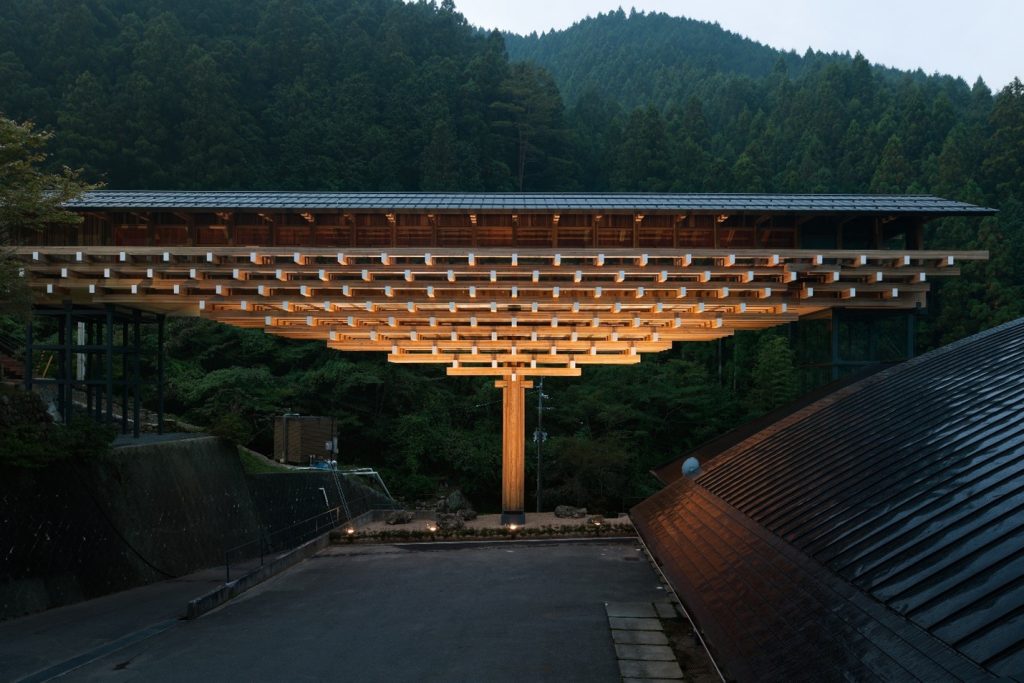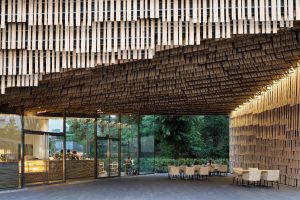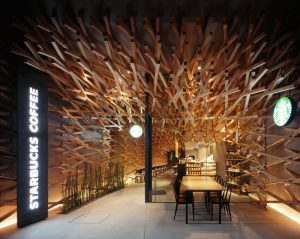
- ARAB NEWS
- 12 Jul 2025

Nader Sammouri
OSAKA: Kengo Kuma’s work is a perfect interplay between elements of the past and an optimistic solid future, often displayed in a diverse and boldly manner that interprets traditions while framing nature. Meeting any of his buildings, one witnesses a unique attribute – courage.
Kuma is regarded as one of the most significant contemporary Japanese architects who accomplished countless creative landmarks in Japan and worldwide and who is known for his atomizing strategy in design.
Kuma spoke to Arab News Japan and taught a lesson in architecture and design. “Architecture should not be independent, but should always be indulging in a relationship with neighbors, gardens, and the surrounding environment,” Kuma said.
He stressed that idea multiple times, saying: “Architecture is a relationship.”
A Non-Nostalgic Past
“The land in Japan is tiny, and the built-up area is much smaller than other countries. Though Japan is populated, its cities are harmonious. The secret to that was wood, which has a limited span. This resulted in soft and intimate human-scale buildings, which matched the environment and created a comfortable place for people,” Kuma said.
Kuma expressed his approach to design, which was heavily influenced by traditional Japanese architecture and its elements.
“The temple has a big, beautiful, shaded void that one can view from the inside. In my opinion, that kind of void is more attractive than volume. That nothingness in space, I think, is beautiful.”

Emptiness in Japanese culture is much respected, and ironically, a lot of space is given for emptiness. It is a pause in the architectural space that is filled with unseen energy, speaking in silence. Emptiness is a profound philosophy that transcends architecture to the rest of the Japanese arts and even way of life.
An element that Kuma likes to borrow from traditional ways of design is transparency.
“The transparency that I like to embed in my work is the super juxtaposition of the layers, and by the method of super juxtaposition, I think we can bring nature closer to us. A wall’s opaqueness separates, but if we manage to create transparency, we can feel the connection with nature,” Kuma said.

However, Kuma avoids creating nostalgic copies and doesn’t want to replicate but to create uniqueness.
“Traditional architecture might have been a perfect fit for previous societies, but society now is much more complex. Environmentally, we are also facing a crisis, and thus, we should always come up with new solutions that fit our current happening situations,” Kuma added.
In Praise of Wood
Kuma’s projects gravitate towards wood relentlessly. On that, Kuma supposed the following:
“I am very much interested in materiality, and wood happens to be a beautiful material that I love and use in many of my work. Sometimes, I work with stone, fabric, and even mud which is found in Arabian countries. I want to enhance the beauty of each material.”
It is hard to imagine traditional Japan without wood which dominates its architecture, interior elements, and crafts.
“The softness and flexibility of wood have fitted to the Japanese lifestyle as well as the Japanese mentality. Hence the relationship between Japanese people and the wooden material proved to be a match,” Kuma said and added:
“From my standpoint, we should forget concrete and steel and go back to natural materials.”

Kuma sees wood as a “happy material”. He praised wood, saying:
“When I touch wood, I receive a strong connection, and I feel like wood is my friend due to its texture, warm temperature, and softness. On the other hand, when I touch concrete, I don’t receive a friendly feeling at all.”
Kuma deliberates that concrete is distant from human nature and gives a cold and emotionless impression. Wood, alternatively, is more inviting and relatively well-received by people. He also expressed how Homo sapiens originated from the forest and lived with the wooden texture that contributed to people’s survival. That memory is deeply ingrained in people and explains a lot about the warm relationship between people and wood.
“I know about the beautiful pine and cedars of Lebanon. My image is that wood is sometimes used for buildings in Lebanon as well,” the architect said.
Kuma thinks that wood has excellent potential in affordable housing as well. It exists everywhere, especially in Japan, where almost 70% of the land is forest.
“If we were able to utilize wood more smartly, we could drop the cost of the house. Wood is flexible and can adapt to our lifestyle,” Kuma told Arab News Japan.
Japanese carpenters are very skillful, humble, and their labor is inexpensive. Historically, wood was always the cheapest material compared to other materials, at least in Japan. Nevertheless, Kuma expressed that it is an unfortunate fact that countless Japanese companies take advantage of this relatively low-cost skill by raising the cost of the building to maximize their profit margin.

One might wonder how beautiful designs using wood could become accessible to ordinary people when constructing their own houses. On that, Kuma commented:
“I built the family house with my father, who was an architect as well. That experience taught me many things about design. Japanese carpenters created the skeletal frame and outer skin of our house, and my father and I built the whole interior of the house with our own hands. That is the kind of democratization of housing that we need in our societies to make good design accessible. I believe that democratizing architecture is one of the goals of our practice of architecture.”
Arabian Musings
Kuma expressed his opinion about the nature of the emirates, particularly Dubai. He explained that as long as there are north and south, and as long as the sun is rising and falling, and the wind is flowing from specific directions, then nature exists, and there is a relationship which nature has already started initiating, and which architecture should complete harmoniously.
“Nature is everywhere around us. The desert is not abstract but a very complex environment. Thus when building in Dubai, for instance, one should think about that relationship between the building and the desert,” Kuma said.
One of the projects that Kuma designed is the red sea project in Saudi Arabia. Inspired by the gentle flowing surfaces of the desert, a symbiosis between culture and nature was echoed in his design.
“I think that the desert is a very spiritual space. I travelled to the Sahara desert when I was a student, and I experienced many spiritual things there. Sand storms and the sun shining on the sand were very spiritual scenes for me,” he said.
“I travelled to the Middle-East several times, and I love the nature and culture there. To work there for some of my projects was surely stimulating for me. The weather in Japan is very wet and humid, but the parts I have visited in the Middle-East were very dry. It brought me joy to work in a novel place with such a diverse nature,” Kuma explained.
When meeting Kengo Kuma, one will hardly fail to notice his absolute openness to experience. After all the travel, experiences, and world-wide recognition that he earned, he still humbly reveals a fervor to experience further and explore new places that he hasn’t seen before.
“Curiosity is the basis of my creation. I visited around 30 countries, more or less, which is still a small portion of the world. I want to experience working in new places with different climates and with people more and more,” he added.
Kuma wishes to be indulged in the diversity that the world offers, which he found striking and beautiful.
“Diversity is the beauty in the world. I want to experience it, absorb it, and then express it through my architectural designs,” Kuma said.
Kuma stressed the prominence of collaboration and mutual exchange to create novel values and design attitudes and explained that innovative things are always happening everywhere for a simple reason, that is, people thrive on accomplishing unique work. Therefore, there is no need to worry about the disappearance of locality, because while it might seem like diversity is disappearing, a new kind of diversity is also emerging.
“We can take various hints from Arab countries, and though vastly different from the Japanese, there are still common experiences and feelings that I sometimes feel. Collaboration between Arabian countries and Japan is crucial for the future because it is the basis of diversity. An exchange between both regions will create new values and new approaches to design,” Kuma said.
Invisible Architecture
In the past few decades, IT engineers have been referred to as architects. This shift may have struck architects driving them to wonder whether the creation of architecture has become a part of the online world, an invisible architecture, where building blocks are code rather than masses of wood and concrete. One may marvel over what is this digital shift bringing to the physical field.
Regarding that Kuma noted saying:
“Physical architecture is a kind of training to build the online digital system, and studying feasible architecture helps create the IT ‘urban’ system. Using our hands is still crucial to activate the brain. And the real world gives us many hints about the system and structure. In the end, physical architecture and the invisible online architecture are both necessary for us.”
Architecture of Happiness
Happiness is under-spoken when it comes to design. However, one of the primary purposes of design is to provide happiness for people. Kuma agreed and said:
“Happiness is essential. However, in the 21st century, people have somehow forgotten about happiness in architectural design and ended up thinking only about function, efficiency, and resilience.”
It may seem true that humanity is getting more and more involved with a way of life that no longer speaks to its earliest instincts.
“I think architecture and happiness are very much related and must be connected. Materiality is one key for human happiness, which I try to use to bring out joy through architecture,” Kuma said.
Inspirations from Nature’s Pandemic
Kuma expressed how the pandemic that we have been experiencing is a happening of nature and an opportunity to reflect and seize ideas.
“I think that the pandemic is a kind of a turning point in history. Before the pandemic, our space was the city and beyond. We were heading more in that kind of direction that is openness-seeking. Now we are forced into enclosed and private spaces. That kind of enclosure could be very stressful for us,” Kuma reflected and expressed how the pandemic had taught him about the risk of such an enclosure, which more people are beginning to feel the need to escape.
“Enclosure is not happiness. ‘Less is more’ is often misunderstood. Going back to nature offers the happiness and satisfaction that we need. Less, I think, is to go back to nature,” Kuma explained.
Today, we have realized that we are a part of nature and not its ruler.
There are so many things that modern society has swept under the carpet, but then nature seems to have its ways to remind the people of its power.
With that reminder in mind, we can re-examine our lives and start to adjust it to live more in harmony with nature in everything we do, including the food we eat, the clothes we wear, and the architecture that we build.